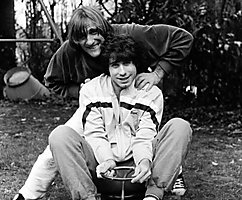Photos that changed the world.
 Bashny.Net
Bashny.Net
The advent of photography itself has changed the world. Any event can now leave their mark on history. Here is the story of the 13 shots that changed our mind and to some extent changed the view of reality.
1. Photo, raise photographers
«Omaha Beach, Normandy, France," Robert Capa 1944
Military photojournalist Robert Capa said that if your photos are bad, it means that you were not close enough to the scene. And he knew what he was talking about. His most famous pictures were taken the morning of June 6, 1944, when, together with the first detachment of infantry, he went to the bank on the day of the Normandy D-Day landings.
Came under fire, Capa was forced to dive under the water with the camera, to avoid the bullets. He barely escaped. Of the four films have taken a picture the day the terrible battle, survived only 11 shots - the others were hopelessly spoiled by the elderly as a laboratory, which is in a hurry lit almost all the material (as it turned out, he tried to have time to show the film before putting into print the latest issue of the journal Life).
Ironically, it is this error in the development of film and gave a few extant photographs of the famous "surreal" appearance (Life magazine in comments to photos incorrectly assumed that they were "a little out of focus"). Fifty years later the director Steven Spielberg on the set of the Normandy landings scene from the movie "Saving Private Ryan" has tried to recreate the effect of the photos of Robert Capa, removing lens cameras protective film for the effect of "blurring».
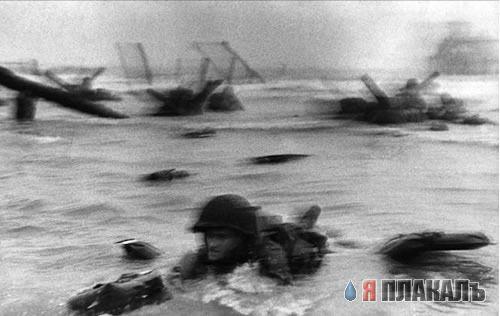
2. The photo, which showed the face of the Great Depression.
"Mother of immigrants," Dorothea Lange 1936
Thanks to the legendary photographer Dorothea Lange, for many years Florence Owen Thompson was literally the personification of the Great Depression. Lange took the picture during a visit to Camp vegetable pickers in California in February 1936, wanting to show the world the fortitude and resilience proud nation in difficult times.
The life story of Dorothy was the same attraction as her portrait. At the age of 32, she was already the mother of seven children and a widow (her husband died of tuberculosis). Once virtually penniless in a labor camp for displaced people, her family ate meat birds that managed to shoot children and vegetables from the farm - as lived and the remaining 2 500 workers camp.
Publication of photos bombshell. History Thompson appeared on the covers of the most respected publications, triggered an immediate response from the public. The administration for displaced persons immediately sent to the camp food and other essentials. Unfortunately, the Thompson family by this time had already left their homes, and the bounty of the government did not get anything. It should be noted that while the name of the woman depicted in the photograph, no one knew. Only forty years after the publication of this picture, in 1976 Thompson "opened" itself, giving an interview to a national newspaper.
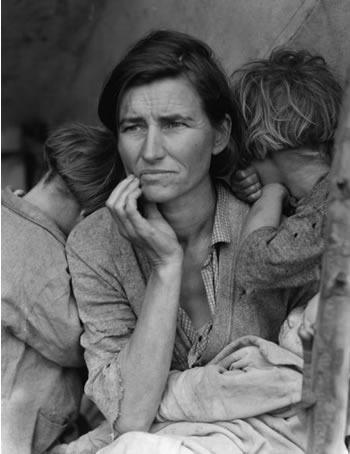
3. Photo, admitted that the war in every home
"Soldiers of the federal troops who fell on the first day of the Battle of Gettysburg, Pennsylvania," Brady Myuttyu 1863
One of the first war photographers Matthew Brady was known as the creator of daguerreotypes Abraham Lincoln and Robert E. Lee. Brady had everything: career, money, their own business. And all this (as well as his own life), he decided to take the risk, following the army of northerners with a camera in hand. Narrowly escaped capture in the very first battle in which he was involved, several Brady lost his patriotic fervor and began sending assistants to the front. In just a few years of war, Brady and his team have done a 7000 shots. That's a pretty impressive figure, especially if we take into account that in order to make a single shot, required equipment and chemicals, is placed inside a covered wagon that carried several horses. Not very much like the familiar digital "Soap»?
Photos, seemed so relevant on the battlefield, had a very heavy aura. However, it is thanks to them that ordinary Americans for the first time could see the bitter and harsh military reality, not a veiled jingoistic slogans.
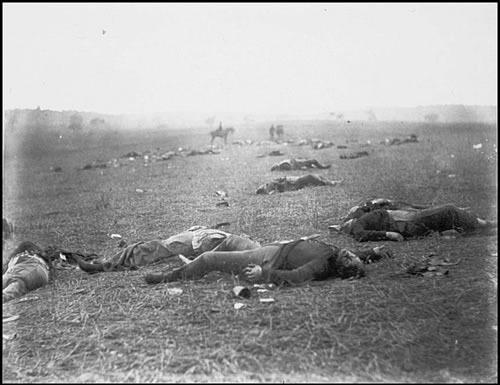
4. Photography, which helped end the war and destroy life
"The killing of Viet Cong committed by the police chief of Saigon," Eddie Adams, 1968
One news agency AP photojournalist Eddie Adams wrote: "Photography - is the most powerful weapon in the world." Very suitable quote for illustrations for his own life - in 1968 his photograph officer shot in the head handcuffed prisoner, not only won the Pulitzer Prize in 1969, but also completely changed the attitude of Americans to what happened in Vietnam. Despite the obviousness of the image, in fact, photography is not as straightforward as it seemed ordinary Americans, was filled with sympathy for the executed. The fact that the man in handcuffs - Captain Viet Cong "warriors of vengeance", and on this day he and his henchmen were shot are many unarmed civilians. Gen. Nguyen Ngoc Loan, shown in the photo on the left, all his life haunted his past: he refused to be treated in an Australian military hospital, after moving to the US, he was faced with a massive campaign calling for his immediate deportation, the restaurant he opened in Virginia, every day He was attacked by vandals. "We know who you are!" - This inscription pursued General of the Army all his life.
"He killed a man in handcuffs," - said Eddie Adams - "I killed him with his camera».

5. The photo with a complete lack of romance
"Victory Day, Times Square, 1945" or "Kiss" Alfred Eisenstaedt, 1945
August 14, 1945 the news of the surrender of Japan ushered in the end of the Second World War. Stormy celebration began on the streets of New York, but perhaps none of the residents did not feel at that moment more free than the military.
Among the lucky people who had gathered that day in Times Square, and was one of the most talented photographers of the 20th century, a German immigrant named Alfred Eisenstaedt. Snatching his camera picture of the celebration, he noticed a sailor, "walking down the street and grab every girl in the field of vision." He later explained that he did not care whether she was "Grandma, strong, thin, old or young," - it does not It makes no difference.
Of course, the photo sailor kiss imprinted on the lips of the venerable pensioner, never would have appeared on the cover of Life, but when the dashing military whirled in dancing and kissing an attractive nurse, and Eisenstadt, take a picture, the image was reprinted by newspapers across the country. Needless to say, photography "Victory Day" was not the image of a meeting of two lovers separated by war. However, it still remains strong symbol of America at the end of a long struggle for peace.

6. Photo, destroyed the airship
"The airship Hindenburg", Murray Becker 1937
The explosion of the airship «Hindenburg» in 1937 - is, of course, do not wreck of "Titanic" and the Chernobyl tragedy of the 20th century.
Of the 97 people on board are miraculously survived 62. During the landing at the airport Leykharst, NJ, after a flight from Germany blew up a German zeppelin Hindenburg. The envelope was filled with hydrogen and helium are not safe inert, because the Americans at that time had refused to sell this gas potential enemy: a new world war was approaching. The event was shot on film 22 pictures. After what happened airships are no longer considered safe and developing transport. This picture has fixed the end of the airship.
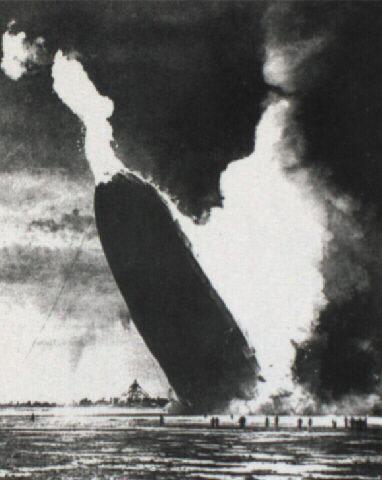
7. photography, which has saved the planet
"Valley of the Snake River" Ansel Adams 1942
Many believe that the era of photography can be divided into two parts: before and after Adams Adams. In "doadomsovskuyu" era picture is not considered as an independent art. Photos by various manipulations done similar to the picture.
Adams is by all means avoid any manipulation of images, photographic art by declaring "the poetry of reality." His work, he proved the value of "pure art of photography." In the era of the appearance of a rather compact portable camera he stubbornly stuck to old-fashioned bulky equipment and large-format cameras.
Adams showed the Americans the beauty of a national nature. In 1936 he made a series of photos and sent them to Washington to help keep the Kings Canyon in California. As a result, the area was declared a national park.

8. Photography, Relive Che Guevara
"The body of Che Guevara," Freddie Alborta 1967
Cutthroat? Sociopath? Candle socialism? Or, as he called his existentialist Jean-Paul Sartre, "the most perfect man of the century"? Regardless of your view of Ernesto "Che" Guevara has long become the patron saint of "revolutionaries of the world. No doubt he - a man of legend, where he was awarded this status is not life and his own death.
Unhappy with the efforts of Che aimed at promoting revolution among the poor and oppressed layers of the population of Bolivia, the national army (trained and equipped by US forces and the CIA) captured and executed Che Guevara in 1967. But before dumping his body in a secret grave, murderers gathered around him, posing for staged photography. The military wanted to prove to the world that Che is dead, hoping that his political movement would die with him. While waiting for the charges that the photo falsified, prudent executioners Che Guevara amputated his hands and preserved them in formaldehyde.
But killing a man, Bolivian officials unwittingly gave rise to the legend about him. Picture that went round the whole world, had a striking resemblance to the Renaissance image of Jesus, removed from the cross. Che's face eerily calm, and his killer preen for the camera, one of them points to the wound in the body of Che Guevara
The allegorical significance photos immediately picked up by supporters of Che, inventing the slogan "Che lives!". Through this picture, Che Guevara will be forever remembered as a martyr who died for socialist ideas.
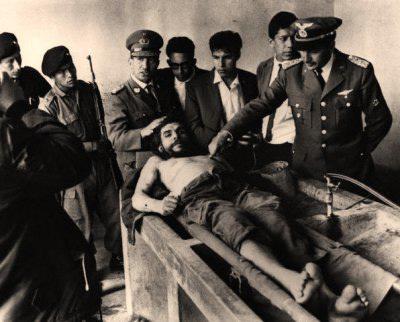
9. photography, show that geniuses have a sense of humor
"Einstein, showing the language", Arthur Seyss 1951
You can rightly ask: "but this photo really changed the world?"
Eynshneyn made a revolution in nuclear physics and quantum mechanics, and that picture has changed attitudes to both Einstein and the scientists in general. The fact that the 72-year-old scientist was tired of the constant persecution of the press, get him on the campus of Princeton. When asked in the one hundred thousandth time to smile at the camera, instead of a smile he presented to the chamber Arthur Seyssa protruding tongue. This language - the language of genius, it is therefore photograph became an instant classic. Now, Einstein will always be remembered and considered a great original - always!

10. Photographs taken surreal reality
"Dal? Atomicus ", Philippe Haltsman 1948
Philip Haltsman was the only photographer who has made a career on the set of people ... jump. He argued that the jump in the subject inadvertently reveals his true, inner self. With this statement we can not agree, looking at the photo of Salvador Dali called "Dal? Atomicus ".
6 hours and 28 jumps, a roomful of assistants, flipping in the air a bucket of water and of angry cats - so was born this photo. In the background picture is not yet finished masterpiece surreal Dali «Leda Atomica». Haltsman wanted to pour a bucket of water is not, and milk, but after the war it was too dismissive in relation to food products.
Celebrity Photos jump authorship Haltsmana appeared at least seven Life magazine covers and gave rise to a new kind of portraits - without necessarily still static.
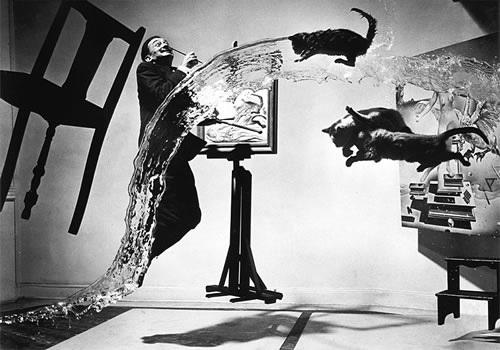
11. Photo, which we deceived
"The monster of Loch Ness" or "surgeon's photo" Ian Wetherell 1934
Yet this picture is called "Photo of the surgeon." This is a vague picture taken in April 1934, it is well known around the world. It is a period of 60 years nurtured the most improbable assumptions about the living fossil lizards living in our days in Loch Ness, has generated a lot of rumors and speculation, it has initiated several underwater expeditions and gave rise to an entire industry of tourism in the small Scottish town. It was not until 1994, is the adopted son of the author of falsification - Christian Sperling - has not told the public that his stepfather, Marmaduke Wetherell, hired by the London Daily Mail newspaper to find a large animal, failed to find him, and decided to make it a fake photo using stepson Christian and his son Ian. It Ian is the author of the actual pictures. "Nessie" was designed in haste and maintained on the surface by using a toy submarine and the counterweight of the boards.
In order to look more believable story, fraudsters persuaded local surgeon Robert Kenneth Wilson named authors snapshot
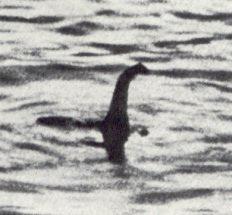
12. Photo, which turned at the last moment
"Gandhi and his spinning wheel," Margaret Bourke-White, 1946
One of the most influential people of the 20th century, Gandhi did not like to be photographed, but in 1946 a staffer Life, Margaret Bourke-White, was allowed to make his picture on the background of spinning wheel - the symbol of the struggle for Indian independence. Before the photographer admitted to the photo shoot, she herself had to learn how to use a spinning wheel - these were the requirements surrounding Gandhi. After overcoming this obstacle Margaret had two. For a start it was found out that the Gandhi is forbidden to start talking - he was just a "day of silence", which he traditionally spent, with no one talking. And because he could not stand bright lights, Margaret was allowed to make only three shots (followed by three flash units). The problem was also very humid atmosphere in India, which has a negative impact on the camera, so the first two photos were unsuccessful, but the third shot turned out. It was he who formed the image of Gandhi, for millions of people. Photo was the last lifetime portrait of Gandhi - two years later he was killed.
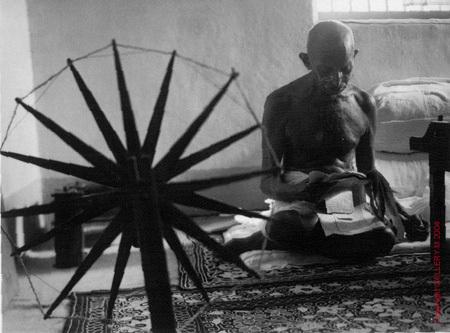
13. Photo, which anticipated the future.
"Le Violon d'Ingres", Man Ray 1924
Before the epoch of digital photography and Photoshop (Photoshop), was the era of Man Ray. One of the most famous and original photographers of the world tirelessly experimented with photographic images.
Photo "Le Violon d'Ingres" is his earliest and probably best-known work. It is a kind of visual pun, while stressing the similarity of the female body with the body Violin and sending the audience to associate with the French painter Jean-Auguste-Dominiqe Ingres, who painted nude women and accompanied by the show of his paintings playing the violin.
Work intellectual-Dadaist Man Ray's ahead of its time. Defining photography as a means of artistic interpretation of reality, Man Ray had anticipated our revolution in digital photography.
Posted in [mergetime] 1186780327 [/ mergetime]
Well sopstna ... Yes, there is an alternative - pendossky look at this thing ... Here: pinguy.infogami.com/blog/vwm6
See comrades, read, think!
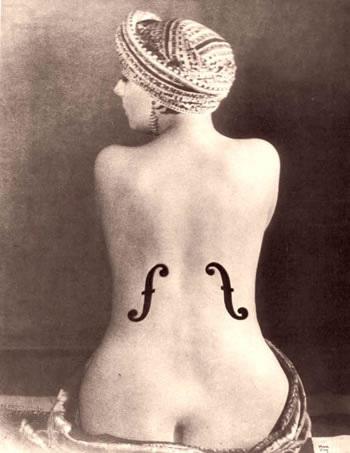
Source:
1. Photo, raise photographers
«Omaha Beach, Normandy, France," Robert Capa 1944
Military photojournalist Robert Capa said that if your photos are bad, it means that you were not close enough to the scene. And he knew what he was talking about. His most famous pictures were taken the morning of June 6, 1944, when, together with the first detachment of infantry, he went to the bank on the day of the Normandy D-Day landings.
Came under fire, Capa was forced to dive under the water with the camera, to avoid the bullets. He barely escaped. Of the four films have taken a picture the day the terrible battle, survived only 11 shots - the others were hopelessly spoiled by the elderly as a laboratory, which is in a hurry lit almost all the material (as it turned out, he tried to have time to show the film before putting into print the latest issue of the journal Life).
Ironically, it is this error in the development of film and gave a few extant photographs of the famous "surreal" appearance (Life magazine in comments to photos incorrectly assumed that they were "a little out of focus"). Fifty years later the director Steven Spielberg on the set of the Normandy landings scene from the movie "Saving Private Ryan" has tried to recreate the effect of the photos of Robert Capa, removing lens cameras protective film for the effect of "blurring».

2. The photo, which showed the face of the Great Depression.
"Mother of immigrants," Dorothea Lange 1936
Thanks to the legendary photographer Dorothea Lange, for many years Florence Owen Thompson was literally the personification of the Great Depression. Lange took the picture during a visit to Camp vegetable pickers in California in February 1936, wanting to show the world the fortitude and resilience proud nation in difficult times.
The life story of Dorothy was the same attraction as her portrait. At the age of 32, she was already the mother of seven children and a widow (her husband died of tuberculosis). Once virtually penniless in a labor camp for displaced people, her family ate meat birds that managed to shoot children and vegetables from the farm - as lived and the remaining 2 500 workers camp.
Publication of photos bombshell. History Thompson appeared on the covers of the most respected publications, triggered an immediate response from the public. The administration for displaced persons immediately sent to the camp food and other essentials. Unfortunately, the Thompson family by this time had already left their homes, and the bounty of the government did not get anything. It should be noted that while the name of the woman depicted in the photograph, no one knew. Only forty years after the publication of this picture, in 1976 Thompson "opened" itself, giving an interview to a national newspaper.

3. Photo, admitted that the war in every home
"Soldiers of the federal troops who fell on the first day of the Battle of Gettysburg, Pennsylvania," Brady Myuttyu 1863
One of the first war photographers Matthew Brady was known as the creator of daguerreotypes Abraham Lincoln and Robert E. Lee. Brady had everything: career, money, their own business. And all this (as well as his own life), he decided to take the risk, following the army of northerners with a camera in hand. Narrowly escaped capture in the very first battle in which he was involved, several Brady lost his patriotic fervor and began sending assistants to the front. In just a few years of war, Brady and his team have done a 7000 shots. That's a pretty impressive figure, especially if we take into account that in order to make a single shot, required equipment and chemicals, is placed inside a covered wagon that carried several horses. Not very much like the familiar digital "Soap»?
Photos, seemed so relevant on the battlefield, had a very heavy aura. However, it is thanks to them that ordinary Americans for the first time could see the bitter and harsh military reality, not a veiled jingoistic slogans.

4. Photography, which helped end the war and destroy life
"The killing of Viet Cong committed by the police chief of Saigon," Eddie Adams, 1968
One news agency AP photojournalist Eddie Adams wrote: "Photography - is the most powerful weapon in the world." Very suitable quote for illustrations for his own life - in 1968 his photograph officer shot in the head handcuffed prisoner, not only won the Pulitzer Prize in 1969, but also completely changed the attitude of Americans to what happened in Vietnam. Despite the obviousness of the image, in fact, photography is not as straightforward as it seemed ordinary Americans, was filled with sympathy for the executed. The fact that the man in handcuffs - Captain Viet Cong "warriors of vengeance", and on this day he and his henchmen were shot are many unarmed civilians. Gen. Nguyen Ngoc Loan, shown in the photo on the left, all his life haunted his past: he refused to be treated in an Australian military hospital, after moving to the US, he was faced with a massive campaign calling for his immediate deportation, the restaurant he opened in Virginia, every day He was attacked by vandals. "We know who you are!" - This inscription pursued General of the Army all his life.
"He killed a man in handcuffs," - said Eddie Adams - "I killed him with his camera».

5. The photo with a complete lack of romance
"Victory Day, Times Square, 1945" or "Kiss" Alfred Eisenstaedt, 1945
August 14, 1945 the news of the surrender of Japan ushered in the end of the Second World War. Stormy celebration began on the streets of New York, but perhaps none of the residents did not feel at that moment more free than the military.
Among the lucky people who had gathered that day in Times Square, and was one of the most talented photographers of the 20th century, a German immigrant named Alfred Eisenstaedt. Snatching his camera picture of the celebration, he noticed a sailor, "walking down the street and grab every girl in the field of vision." He later explained that he did not care whether she was "Grandma, strong, thin, old or young," - it does not It makes no difference.
Of course, the photo sailor kiss imprinted on the lips of the venerable pensioner, never would have appeared on the cover of Life, but when the dashing military whirled in dancing and kissing an attractive nurse, and Eisenstadt, take a picture, the image was reprinted by newspapers across the country. Needless to say, photography "Victory Day" was not the image of a meeting of two lovers separated by war. However, it still remains strong symbol of America at the end of a long struggle for peace.

6. Photo, destroyed the airship
"The airship Hindenburg", Murray Becker 1937
The explosion of the airship «Hindenburg» in 1937 - is, of course, do not wreck of "Titanic" and the Chernobyl tragedy of the 20th century.
Of the 97 people on board are miraculously survived 62. During the landing at the airport Leykharst, NJ, after a flight from Germany blew up a German zeppelin Hindenburg. The envelope was filled with hydrogen and helium are not safe inert, because the Americans at that time had refused to sell this gas potential enemy: a new world war was approaching. The event was shot on film 22 pictures. After what happened airships are no longer considered safe and developing transport. This picture has fixed the end of the airship.

7. photography, which has saved the planet
"Valley of the Snake River" Ansel Adams 1942
Many believe that the era of photography can be divided into two parts: before and after Adams Adams. In "doadomsovskuyu" era picture is not considered as an independent art. Photos by various manipulations done similar to the picture.
Adams is by all means avoid any manipulation of images, photographic art by declaring "the poetry of reality." His work, he proved the value of "pure art of photography." In the era of the appearance of a rather compact portable camera he stubbornly stuck to old-fashioned bulky equipment and large-format cameras.
Adams showed the Americans the beauty of a national nature. In 1936 he made a series of photos and sent them to Washington to help keep the Kings Canyon in California. As a result, the area was declared a national park.

8. Photography, Relive Che Guevara
"The body of Che Guevara," Freddie Alborta 1967
Cutthroat? Sociopath? Candle socialism? Or, as he called his existentialist Jean-Paul Sartre, "the most perfect man of the century"? Regardless of your view of Ernesto "Che" Guevara has long become the patron saint of "revolutionaries of the world. No doubt he - a man of legend, where he was awarded this status is not life and his own death.
Unhappy with the efforts of Che aimed at promoting revolution among the poor and oppressed layers of the population of Bolivia, the national army (trained and equipped by US forces and the CIA) captured and executed Che Guevara in 1967. But before dumping his body in a secret grave, murderers gathered around him, posing for staged photography. The military wanted to prove to the world that Che is dead, hoping that his political movement would die with him. While waiting for the charges that the photo falsified, prudent executioners Che Guevara amputated his hands and preserved them in formaldehyde.
But killing a man, Bolivian officials unwittingly gave rise to the legend about him. Picture that went round the whole world, had a striking resemblance to the Renaissance image of Jesus, removed from the cross. Che's face eerily calm, and his killer preen for the camera, one of them points to the wound in the body of Che Guevara
The allegorical significance photos immediately picked up by supporters of Che, inventing the slogan "Che lives!". Through this picture, Che Guevara will be forever remembered as a martyr who died for socialist ideas.

9. photography, show that geniuses have a sense of humor
"Einstein, showing the language", Arthur Seyss 1951
You can rightly ask: "but this photo really changed the world?"
Eynshneyn made a revolution in nuclear physics and quantum mechanics, and that picture has changed attitudes to both Einstein and the scientists in general. The fact that the 72-year-old scientist was tired of the constant persecution of the press, get him on the campus of Princeton. When asked in the one hundred thousandth time to smile at the camera, instead of a smile he presented to the chamber Arthur Seyssa protruding tongue. This language - the language of genius, it is therefore photograph became an instant classic. Now, Einstein will always be remembered and considered a great original - always!

10. Photographs taken surreal reality
"Dal? Atomicus ", Philippe Haltsman 1948
Philip Haltsman was the only photographer who has made a career on the set of people ... jump. He argued that the jump in the subject inadvertently reveals his true, inner self. With this statement we can not agree, looking at the photo of Salvador Dali called "Dal? Atomicus ".
6 hours and 28 jumps, a roomful of assistants, flipping in the air a bucket of water and of angry cats - so was born this photo. In the background picture is not yet finished masterpiece surreal Dali «Leda Atomica». Haltsman wanted to pour a bucket of water is not, and milk, but after the war it was too dismissive in relation to food products.
Celebrity Photos jump authorship Haltsmana appeared at least seven Life magazine covers and gave rise to a new kind of portraits - without necessarily still static.

11. Photo, which we deceived
"The monster of Loch Ness" or "surgeon's photo" Ian Wetherell 1934
Yet this picture is called "Photo of the surgeon." This is a vague picture taken in April 1934, it is well known around the world. It is a period of 60 years nurtured the most improbable assumptions about the living fossil lizards living in our days in Loch Ness, has generated a lot of rumors and speculation, it has initiated several underwater expeditions and gave rise to an entire industry of tourism in the small Scottish town. It was not until 1994, is the adopted son of the author of falsification - Christian Sperling - has not told the public that his stepfather, Marmaduke Wetherell, hired by the London Daily Mail newspaper to find a large animal, failed to find him, and decided to make it a fake photo using stepson Christian and his son Ian. It Ian is the author of the actual pictures. "Nessie" was designed in haste and maintained on the surface by using a toy submarine and the counterweight of the boards.
In order to look more believable story, fraudsters persuaded local surgeon Robert Kenneth Wilson named authors snapshot

12. Photo, which turned at the last moment
"Gandhi and his spinning wheel," Margaret Bourke-White, 1946
One of the most influential people of the 20th century, Gandhi did not like to be photographed, but in 1946 a staffer Life, Margaret Bourke-White, was allowed to make his picture on the background of spinning wheel - the symbol of the struggle for Indian independence. Before the photographer admitted to the photo shoot, she herself had to learn how to use a spinning wheel - these were the requirements surrounding Gandhi. After overcoming this obstacle Margaret had two. For a start it was found out that the Gandhi is forbidden to start talking - he was just a "day of silence", which he traditionally spent, with no one talking. And because he could not stand bright lights, Margaret was allowed to make only three shots (followed by three flash units). The problem was also very humid atmosphere in India, which has a negative impact on the camera, so the first two photos were unsuccessful, but the third shot turned out. It was he who formed the image of Gandhi, for millions of people. Photo was the last lifetime portrait of Gandhi - two years later he was killed.

13. Photo, which anticipated the future.
"Le Violon d'Ingres", Man Ray 1924
Before the epoch of digital photography and Photoshop (Photoshop), was the era of Man Ray. One of the most famous and original photographers of the world tirelessly experimented with photographic images.
Photo "Le Violon d'Ingres" is his earliest and probably best-known work. It is a kind of visual pun, while stressing the similarity of the female body with the body Violin and sending the audience to associate with the French painter Jean-Auguste-Dominiqe Ingres, who painted nude women and accompanied by the show of his paintings playing the violin.
Work intellectual-Dadaist Man Ray's ahead of its time. Defining photography as a means of artistic interpretation of reality, Man Ray had anticipated our revolution in digital photography.
Posted in [mergetime] 1186780327 [/ mergetime]
Well sopstna ... Yes, there is an alternative - pendossky look at this thing ... Here: pinguy.infogami.com/blog/vwm6
See comrades, read, think!

Source:
Tags
See also
Four trends that will change the view of the professional activities in the next five years
10 smart books about how to rule the world or at least yourself
The usual stuff that has changed beyond recognition
9 practices of Eckhart Tolle that will change your life
Not profitable invention, which is afraid of the world
The words that changed lives
12 laws of karma that will change your life.
7 questions that will change your life
What to do if the ATM ate my card
5 facts about the brain that will change your life

